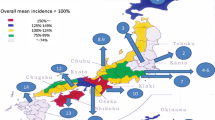Abstract
Our objective was to analyze and compare the associations between potential risk factors for nephrolithiasis and repeat stone surgery in male and female patients. We retrospectively analyzed 1970 patients who had stone surgery at our institution in the period from January 2009 to May 2017, were older than 18 years and had at least 12 months of postoperative follow-up. Our definition of surgical recurrence included repeat surgery on the same renal unit or on the opposite renal unit if the original imaging did not demonstrate significant stones on that side. Uni- and multivariate Cox regression models were built for each gender. We also explored the interactions between gender and other patient’s characteristics in their effect on the risk of recurrence. Ureteroscopy was the most common treatment modality for both first (83%) and repeat (87%) procedures. Over a mean follow-up of 4.3 years (median 3.8, interquartile range 2.2–6.0), 413 (21.0%) patients had a surgical recurrence. In multivariate analyses, hypertension, diabetes, Caucasian race and younger age (less than 60 years) were significantly associated with the risk of surgical recurrence only in females. Interaction between these characteristics and gender was significant indicating a larger effect on the risk of surgical recurrence in females compared to males. Our study demonstrated a number of differences in the predictors of repeat surgery for nephrolithiasis between males and females. If confirmed by future studies these differences may be helpful for optimizing nephrolithiasis prevention efforts.
Similar content being viewed by others
Data availability
Available on request.
References
Scales CD Jr, Smith AC, Hanley JM, Saigal CS (2012) Prevalence of kidney stones in the United States. Eur Urol 62(1):160–165
Lieske JC, Pena de la Vega LS, Slezak JM, Bergstralh EJ, Leibson CL, Ho KL, Gettman MT (2006) Renal stone epidemiology in Rochester, Minnesota: an update. Kidney Int 69(4):760–764
Penniston KL, McLaren ID, Greenlee RT, Nakada SY (2011) Urolithiasis in a rural Wisconsin population from 1992 to 2008: narrowing of the male-to-female ratio. J Urol 185(5):1731–1736
Taylor EN, Stampfer MJ, Curhan GC (2005) Obesity, weight gain, and the risk of kidney stones. JAMA 293(4):455–462
Madore F, Stampfer MJ, Willett WC, Speizer FE, Curhan GC (1998) Nephrolithiasis and risk of hypertension in women. Am J Kidney Dis 32(5):802–807
Madore F, Stampfer MJ, Rimm EB, Curhan GC (1998) Nephrolithiasis and risk of hypertension. Am J Hypertens 11(1 Pt 1):46–53
Ratkalkar VN, Kleinman JG (2011) Mechanisms of Stone Formation. Clin Rev Bone Miner Metab 9(3–4):187–197
Fuster DG, Bobulescu IA, Zhang J, Wade J, Moe OW (2007) Characterization of the regulation of renal Na+/H+ exchanger NHE3 by insulin. Am J Physiol Renal Physiol 292(2):F577-585
Bobulescu IA (2010) Renal lipid metabolism and lipotoxicity. Curr Opin Nephrol Hypertens 19(4):393–402
Powell CR, Stoller ML, Schwartz BF, Kane C, Gentle DL, Bruce JE, Leslie SW (2000) Impact of body weight on urinary electrolytes in urinary stone formers. Urology 55(6):825–830
Ramaswamy K, Shah O (2014) Metabolic syndrome and nephrolithiasis. Transl Androl Urol 3(3):285–295
Bell DS (2012) Beware the low urine pH–the major cause of the increased prevalence of nephrolithiasis in the patient with type 2 diabetes. Diabetes Obes Metab 14(4):299–303
Taylor EN, Stampfer MJ, Curhan GC (2005) Diabetes mellitus and the risk of nephrolithiasis. Kidney Int 68(3):1230–1235
Miano R, Germani S, Vespasiani G (2007) Stones and urinary tract infections. Urol Int 79(Suppl 1):32–36
Schwaderer AL, Wolfe AJ (2017) The association between bacteria and urinary stones. Ann Transl Med 5(2):32
Funding
None.
Author information
Authors and Affiliations
Corresponding author
Ethics declarations
Conflict of interest
The authors has no conflict of interest.
Ethical approval
Obtained.
Additional information
Publisher's Note
Springer Nature remains neutral with regard to jurisdictional claims in published maps and institutional affiliations.
Rights and permissions
About this article
Cite this article
Iremashvili, V., Li, S., Dresner, S.L. et al. Gender-related differences in the risk factors for repeat stone surgery. Urolithiasis 49, 471–476 (2021). https://doi.org/10.1007/s00240-021-01255-5
Received:
Accepted:
Published:
Issue Date:
DOI: https://doi.org/10.1007/s00240-021-01255-5




